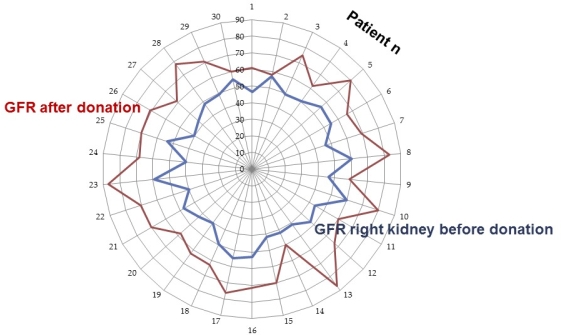Radioisotopic Evaluation of Glomerular Filtration Rate (GFR) before and 1 Year after Kindey Donation for Transplantation: The Concept of Estimated Renal Functional Reserve (eRFR)
V. Cantaluppi,1 G. Guglielmetti,1 M. Mora,1 A. Airoldi,1 F. Orsini,2 M. Quaglia,1 G. Sacchetti,2 C. Ronco.3
1Nephrology and Kidney Transplantation Unit, University of Piemonte Orientale (UPO), Novara, Italy
2Nuclear Medicine Unit, Maggiore della Carità
University Hospital, Novara, Italy
3Nephrology, Dialysis and Kidney Transplantation Unit, International Renal Research Institute (IRRIV), Vicenza, Italy.
Meeting: 2018 American Transplant Congress
Abstract number: B159
Keywords: Donation, Donors, Kidney transplantation, Renal function, unrelated
Session Information
Session Name: Poster Session B: Kidney Living Donor: Long Term Outcomes
Session Type: Poster Session
Date: Sunday, June 3, 2018
Session Time: 6:00pm-7:00pm
 Presentation Time: 6:00pm-7:00pm
Presentation Time: 6:00pm-7:00pm
Location: Hall 4EF
Kidney donors (KD) develop a partial loss of renal function defined as Acute Kidney Injury (AKI). Recovery from AKI is due to renal functional reserve (RFR), the capacity of the kidney to increase GFR. The aim of the study was to analyse estimated RFR by radiosotopic test in 30 KD before and 1 year after nephrectomy.
KD mean age at the time of donation was 54.4 years (min-max, 30-78), serum creatinine 0.73 mg/dL (0.5-0.96), eGFR (CKD-EPI) 99 mL/min/1.73m2 (69-119) and radioisotope (51Cr-EDTA) GFR 101.4 mL/min (78-129). The split function was evaluated by concomitant scintigraphy using 99mTc-MAG: the mean percentage of renal function of right kidney was 48% (43-56) and left 52% (44-57), respectively. After nephrectomy all KD worsened renal function with an increase of serum creatinine of 79% (50-112.2%); 25/30 KD developed AKI stage 1, and 5 AKI stage 2 (KDIGO criteria). Seven days after surgery, renal recovery was observed in all cases. These results suggest a potential gain of about 30% in comparison to the starting value of the right kidney. One year after nephrectomy, we studied KD renal function (GFR) by radioisotopic evaluation using 51Cr-EDTA and we compared it with the split radioisotope (51Cr-EDTA) GFR of right kidney at the first evaluation. Mean GFR was 68.8 mL/min (50-87) vs. 48.6 mL/min (39.7-60.4) before donation with an average GFR increase of 20 mL/min (0.8-45.6) and a percentage increase of the right renal function up to 110% (mean 42%, min 1.4%). 
Radioisotopic GFR evaluation allows the determination of estimated RFR particularly in medically complex KD. We observed a compensatory hypertrophy due to RFR in all 30 KD independently from age and co-morbidities (elevated BMI and hypertension). We have now started a kidney stress test based on protein load.
CITATION INFORMATION: Cantaluppi V., Guglielmetti G., Mora M., Airoldi A., Orsini F., Quaglia M., Sacchetti G., Ronco C. Radioisotopic Evaluation of Glomerular Filtration Rate (GFR) before and 1 Year after Kindey Donation for Transplantation: The Concept of Estimated Renal Functional Reserve (eRFR) Am J Transplant. 2017;17 (suppl 3).
To cite this abstract in AMA style:
Cantaluppi V, Guglielmetti G, Mora M, Airoldi A, Orsini F, Quaglia M, Sacchetti G, Ronco C. Radioisotopic Evaluation of Glomerular Filtration Rate (GFR) before and 1 Year after Kindey Donation for Transplantation: The Concept of Estimated Renal Functional Reserve (eRFR) [abstract]. https://atcmeetingabstracts.com/abstract/radioisotopic-evaluation-of-glomerular-filtration-rate-gfr-before-and-1-year-after-kindey-donation-for-transplantation-the-concept-of-estimated-renal-functional-reserve-erfr/. Accessed December 27, 2025.« Back to 2018 American Transplant Congress
